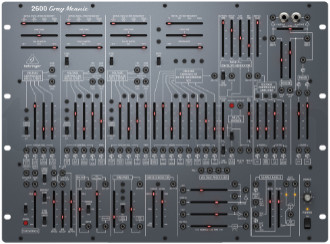 I've always wanted to have an ARP 2600 (produced in the 70's), but never thought I would ever own one, as they had gone out of production in the early 80's, and a fully functioning 2nd hand would cost "an arm and a leg", if you could find any willing to sell one. So for years I had to scratch my ARP 2600 itch, using the Arturia software version of the ARP 2600 (part of Arturia's V-Collection).
I've always wanted to have an ARP 2600 (produced in the 70's), but never thought I would ever own one, as they had gone out of production in the early 80's, and a fully functioning 2nd hand would cost "an arm and a leg", if you could find any willing to sell one. So for years I had to scratch my ARP 2600 itch, using the Arturia software version of the ARP 2600 (part of Arturia's V-Collection).
However this changed when Behringer announced that they were going to produce a new version of the ARP 2600, and I instantly knew I had to get one. I am sure the purist will tell you that the Behringer is not "a real ARP 2600", but it is the closest I will ever get to own one, so for me it's perfect. The ARP 2600 is a semi-modular analog synth with 3 oscillators. Being semi-modular means the modules within the synth are pre-wired. So you can start playing and tweak knobs at once, without inserting any patch cables. However this internal/default wiring can- and will be disabled as soon as you start inserting patch cables. So you are free to change the routing as you see fit. It comes without keyboard and sequencer, but on the back it both have a normal (DIN5) MIDI-port and MIDI via USB. I bought a KORG SQ-1 sequencer that I can either connect via MIDI or CV. The way Behringer "shaped" their ARP 2600 it can both be used as a desktop synth, or be rack-mounted. Personally mine is rack-mounted sitting in an angled K&M42020 rack, with a Behringer Neutron mounted just above it (for each patch between them).
 I though about "expanding my ARP 2600" by buying some of Behringer's System 100 modules and add them in the rack just above the ARP 2600. But in stead I went for the Behringer Neutron. The Neutron (like the ARP) is a semi-modular synthesizer with a large patch-section in the right side. The Neutron features two oscillators, noise-generator, multi-mode filter, 2 ADSR envelopes and a single LFO (well the 2 oscillators goes full range, so these can double as LFO's also) and a few effects. The patch-section is very feature rich both with S&H, summing and attenuation and many other features.
I though about "expanding my ARP 2600" by buying some of Behringer's System 100 modules and add them in the rack just above the ARP 2600. But in stead I went for the Behringer Neutron. The Neutron (like the ARP) is a semi-modular synthesizer with a large patch-section in the right side. The Neutron features two oscillators, noise-generator, multi-mode filter, 2 ADSR envelopes and a single LFO (well the 2 oscillators goes full range, so these can double as LFO's also) and a few effects. The patch-section is very feature rich both with S&H, summing and attenuation and many other features.
While the Neutron have a very "fat" analog sound on its own, my primary reason to get it, was to use it to further modulate my ARP 2600, by patching between the Neutron and the ARP ("poor mans solution" to not have any euro-rack modules). But in some cases the Neutron will be used by itself. I bought the rack-ears for the neutron so both the Neutron and the ARP are mounted in the same angled rack with the Neutron sitting just above the ARP, for easy patching between them. Like the ARP 2600 it both have a traditional (DIN5) MIDI-port and accepts MIDI via USB.